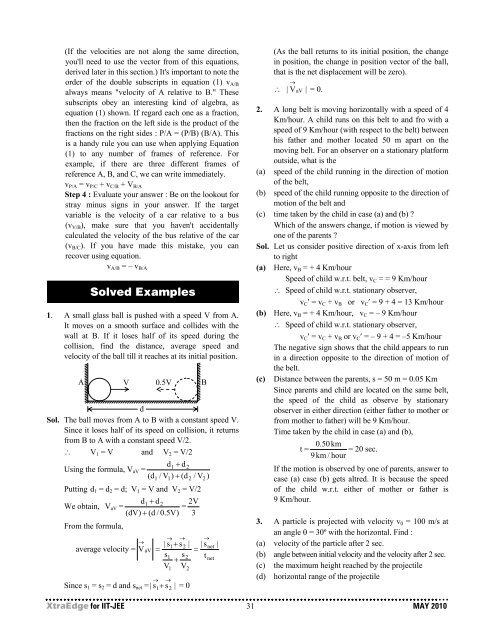You also want an ePaper? Increase the reach of your titles
YUMPU automatically turns print PDFs into web optimized ePapers that Google loves.
(If the velocities are not along the same direction, (As the ball returns to its initial position, the change<br />
→<br />
(d) horizontal range of the projectile<br />
→<br />
Since s 1 = s 2 = d and s net = s + s | = 0<br />
you'll need to use the vector from of this equations,<br />
derived later in this section.) It's important to note the<br />
in position, the change in position vector of the ball,<br />
that is the net displacement will be zero).<br />
order of the double subscripts in equation (1) v A/B<br />
→<br />
always means "velocity of A relative to B." These ∴ | VaV<br />
| = 0.<br />
subscripts obey an interesting kind of algebra, as<br />
equation (1) shown. If regard each one as a fraction,<br />
2. A long belt is moving horizontally with a speed of 4<br />
then the fraction on the left side is the product of the<br />
Km/hour. A child runs on this belt to and fro with a<br />
fractions on the right sides : P/A = (P/B) (B/A). This<br />
speed of 9 Km/hour (with respect to the belt) between<br />
is a handy rule you can use when applying Equation<br />
his father and mother located 50 m apart on the<br />
(1) to any number of frames of reference. For<br />
moving belt. For an observer on a stationary platform<br />
example, if there are three different frames of<br />
outside, what is the<br />
reference A, B, and C, we can write immediately. (a) speed of the child running in the direction of motion<br />
v P/A = v P/C + v C/B + V B/A<br />
of the belt,<br />
Step 4 : Evaluate your answer : Be on the lookout for<br />
stray minus signs in your answer. If the target<br />
(b) speed of the child running opposite to the direction of<br />
motion of the belt and<br />
variable is the velocity of a car relative to a bus<br />
(v V/B ), make sure that you haven't accidentally<br />
calculated the velocity of the bus relative of the car<br />
(c) time taken by the child in case (a) and (b) ?<br />
Which of the answers change, if motion is viewed by<br />
one of the parents ?<br />
(v B/C ). If you have made this mistake, you can<br />
recover using equation.<br />
v A/B = – v B/A<br />
Sol. Let us consider positive direction of x-axis from left<br />
to right<br />
(a) Here, v B = + 4 Km/hour<br />
Speed of child w.r.t. belt, v C = = 9 Km/hour<br />
Solved Examples<br />
∴ Speed of child w.r.t. stationary observer,<br />
v C ′ = v C + v B or v C ′ = 9 + 4 = 13 Km/hour<br />
1. A small glass ball is pushed with a speed V from A.<br />
It moves on a smooth surface and collides with the<br />
wall at B. If it loses half of its speed during the<br />
collision, find the distance, average speed and<br />
velocity of the ball till it reaches at its initial position.<br />
(b) Here, v B = + 4 Km/hour, v C = – 9 Km/hour<br />
∴ Speed of child w.r.t. stationary observer,<br />
v C ′ = v C + v B or v C ′ = – 9 + 4 = –5 Km/hour<br />
The negative sign shows that the child appears to run<br />
in a direction opposite to the direction of motion of<br />
the belt.<br />
A V 0.5V B<br />
(c) Distance between the parents, s = 50 m = 0.05 Km<br />
Since parents and child are located on the same belt,<br />
the speed of the child as observe by stationary<br />
d<br />
Sol. The ball moves from A to B with a constant speed V.<br />
Since it loses half of its speed on collision, it returns<br />
observer in either direction (either father to mother or<br />
from mother to father) will be 9 Km/hour.<br />
Time taken by the child in case (a) and (b),<br />
from B to A with a constant speed V/2.<br />
0.50 km<br />
∴ V 1 = V and V 2 = V/2<br />
t = = 20 sec.<br />
9 km / hour<br />
d1<br />
+ d 2<br />
Using the formula, V aV =<br />
If the motion is observed by one of parents, answer to<br />
(d1<br />
/ V 1)<br />
+ (d 2 / V2<br />
)<br />
case (a) case (b) gets altred. It is because the speed<br />
Putting d 1 = d 2 = d; V 1 = V and V 2 = V/2<br />
of the child w.r.t. either of mother or father is<br />
d1<br />
+ d 2 2V<br />
9 Km/hour.<br />
We obtain, V aV =<br />
=<br />
(dV) + (d / 0.5V) 3<br />
3. A particle is projected with velocity v<br />
From the formula,<br />
0 = 100 m/s at<br />
an angle θ = 30º with the horizontal. Find :<br />
→ → →<br />
→<br />
| s1+<br />
s2<br />
| | snet<br />
| (a) velocity of the particle after 2 sec.<br />
average velocity = VaV<br />
= =<br />
s1<br />
s2<br />
t<br />
(b) angle between initial velocity and the velocity after 2 sec.<br />
+<br />
net<br />
V1<br />
V2<br />
(c) the maximum height reached by the projectile<br />
| 1 2<br />
XtraEdge for <strong>IIT</strong>-<strong>JEE</strong> 31 MAY 2010

















